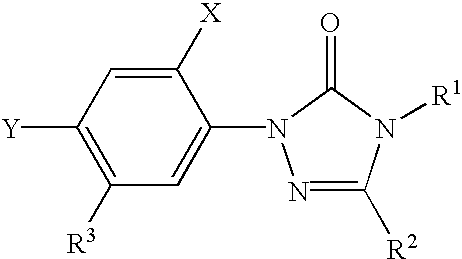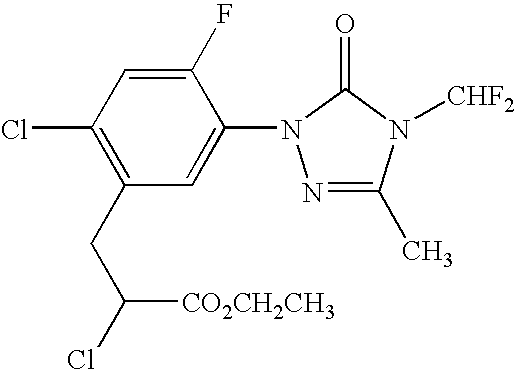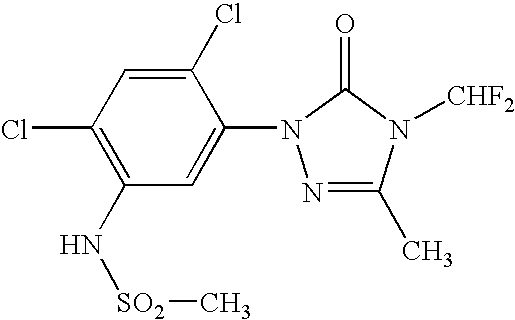Coformulation of an oil-soluble herbicide and a water-soluble herbicide
a technology of herbicide and water-soluble herbicide, which is applied in the field of compositions, can solve the problems of affecting the weed control spectrum of herbicides, affecting the weed control of susceptible plants, and it takes a relatively long time (weeks or more) for susceptible plants to show the visual, etc., and achieves rapid burndown and early visual symptomology, broader weed control spectrum, and high loading of herbicidal active ingredients
- Summary
- Abstract
- Description
- Claims
- Application Information
AI Technical Summary
Benefits of technology
Problems solved by technology
Method used
Image
Examples
example 1
A microemulsion composition was prepared having the following ingredients:
glyphosate IPA salt solution (MON 0139) 67.37%.sup.1 ammonium chloride 1.11% 2N hydrochloric acid 11.31% Solvent (Aromatic 150) 11.93% carfentrazone-ethyl (91.2% active) 0.18% Emulsifier (Ethomeen T / 15) 3.07% Emulsifier (Ethomeen C / 15) 2.95% Dispersant (Surfonic L12-6) 2.09% .sup.1 Equivalent to 41.77% glyphosate IPA active ingredient.
Ammonium chloride (0.45 g) was dissolved in 2N hydrochloric acid (4.60 g) and the resulting solution was mixed with MON 0139 (27.41 g) to form a first mixture. Carfentrazone-ethyl (0.0739 g) was dissolved in Aromatic 150 (4.85 g) to form a second mixture, which was then added to the first mixture with agitation. Finally, surfactants Ethomeen T / 15 (1.25 g), Ethomeen C / 15 (1.20 g) and Surfonic L12-6 (0.85 g) were added and the whole composition was stirred, using an overhead electric stirrer, under moderate agitation for 30 minutes.
The composition was a clear amber microemulsion th...
example 2
A microemulsion composition was prepared having the following ingredients:
glyphosate IPA salt solution (MON 0139) 67.48%.sup.1 ammonium chloride 0.27% water 3.62% 2N hydrochloric acid 11.32% Solvent (Aromatic 150) 2.07% carfentrazone-ethyl (91.2% active) 0.18% Emulsifier (Ethomeen T / 15) 3.27% Emulsifier (Ethomeen C / 15) 1.26% Dispersant (Surfonic L12-6) 2.07% .sup.1 Equivalent to 41.84% glyphosate IPA active ingredient.
Ammonium chloride (0.11 g) was dissolved in water (1.47 g) and 2N hydrochloric acid (4.60 g) and the resulting solution was mixed with MON 0139 (27.41 g) to form a first mixture. Carfentrazone-ethyl (0.0739 g) was dissolved in Aromatic 150 solvent (4.27 g) to form a second mixture, which was then added to the first mixture with agitation. Finally, surfactants Ethomeen T / 15 (1.33 g), Ethomeen C / 15 (0.51 g) and Surfonic L12-6 (0.84 g) were added and the whole composition was stirred, using an overhead electric stirrer, under moderate agitation for 30 minutes.
The composit...
example 3
A microemulsion composition was prepared having the following ingredients:
glyphosate IPA salt solution (MON 0139) 68.29%.sup.1 water 3.31% 2N hydrochloric acid 11.53% Solvent (Aromatic 150) 10.65% carfentrazone-ethyl (91.2% active) 0.18% Emulsifier (Ethomeen T / 15) 4.36% Emulsifier (Ethomeen C / 15) 0.00% Dispersant (Surfonic L12-6) 1.67% .sup.1 Equivalent to 42.34% glyphosate IPA active ingredient.
MON 0139 (27.42 g) was mixed with water (1.33 g) and 2N hydrochloric acid (4.63 g) to form a first mixture. Carfentrazone-ethyl (0.0740 g) was dissolved in Aromatic 150 solvent (4.28 g) to form a second mixture, which was then added to the first mixture with agitation. Finally, surfactants Ethomeen T / 15 (1.75 g) and Surfonic L12-6 (0.67 g) were added and the whole composition was stirred, using an overhead electric stirrer, under moderate agitation for 30 minutes.
The composition was a clear amber microemulsion that was physically stable at -10.degree. C., room temperature (approximately 22.d...
PUM
 Login to View More
Login to View More Abstract
Description
Claims
Application Information
 Login to View More
Login to View More - R&D
- Intellectual Property
- Life Sciences
- Materials
- Tech Scout
- Unparalleled Data Quality
- Higher Quality Content
- 60% Fewer Hallucinations
Browse by: Latest US Patents, China's latest patents, Technical Efficacy Thesaurus, Application Domain, Technology Topic, Popular Technical Reports.
© 2025 PatSnap. All rights reserved.Legal|Privacy policy|Modern Slavery Act Transparency Statement|Sitemap|About US| Contact US: help@patsnap.com



